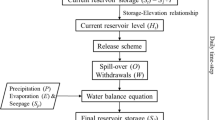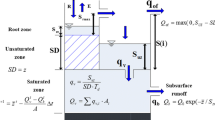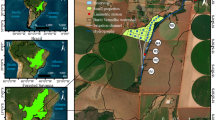Abstract
Extreme rainfall events in an urban area pose various challenges to the water resource managers in terms of flood mitigation, inundation, water conservation and harvesting for drinking water supply. The objective of this study is to apply the box-model approach to evaluate reservoir operation during extreme rainfall events. A large water supply reservoir in Chennai was chosen to carry out this study. A box model, based on input–output parameters, is proposed to simulate the reservoir operation and hydraulic behaviour. Hydrologic Engineering Centre-Hydrologic Modelling System (HEC-HMS) has been used to simulate the reservoir inflow hydrograph and to understand the run-off characteristics of the basin. Three extreme rainfall events occurred in past have been selected for the analysis. Three different scenarios have been framed to assess the reservoir performance. Reducing the initial storage to 50% and releasing water at the beginning of the event gives a possible solution for flood mitigation in reducing the outflow volume by 9–37% and delaying the time to peak by 1–6 h. Though the reduced outflow volume from this reservoir is less, it can help to mitigate the flood inundation to a significant extent. Thus the box-model approach presented here can be utilised as a simple tool to generate the various combinations of outflow hydrographs for any reservoir.















Similar content being viewed by others
References
Ahbari A, Stour L and Agoumi A 2019 Ability of the performance criteria to assess and compare reservoir management approaches; Water Resour. Manag. 33 1541–1555.
Ahmad A, El-shafie A, Razali S F M and Mohamad Z S 2014 Reservoir optimization in water resources: A review; Water Resour. Manag. 28 3391–3405.
Chang J, Guo A, Du H and Wang Y 2017 Floodwater utilization for cascade reservoirs based on dynamic control of seasonal flood control limit levels; Environ. Earth Sci. 76(260) 1–12.
Cheng W M, Huang C L, Hsu N S and Wei C C 2017 Risk analysis of reservoir operations considering short-term flood control and long-term water supply: A case study for the Da-Han Creek Basin; Water (Basel) 9(424) 1–23.
Coerver H M, Rutten M M and Van De Giesen N C 2018 Deduction of reservoir operating rules for application in global hydrological models; Hydrol. Earth Syst. Sci. 22 831–851.
Doan J H 2003 USACE, Geospatial Hydrologic Modeling Extension, HECGeoHMS: User’s Manual; Version 1.1, USACE, Davis, CA, USA.
Feldman A D 2000 USACE (United States Army Corps of Engineers) hydrologic modeling system HEC-HMS: Technical reference manual; USACE, Washington DC, USA.
Hsu N S, Huang C L and Wei C C 2015 Multi-phase intelligent decision model for reservoir real-time flood control during typhoons; J. Hydrol. 522 11–34.
Huang W C and Hsieh C L 2010 Real-time reservoir flood operation during typhoon attacks; Water Resour. Res. 46(W07528) 1–11.
Indian Meteorological Department, Chennai, http://www.imdchennai.gov.in/climate/chennai2.htm.
Kumar P, Tiwari K N and Pal D K 1991 Establishing SCS runoff curve number from IRS digital data base; J. Indian Soc. Remote Sens. 19(4) 245–251.
Li N, Kinzelbach W, Li W P and Dong X G 2015 Box model and 1D longitudinal model of flow and transport in Bosten Lake, China; J. Hydrol. 524 62–71.
Liu P, Li L, Guo S, Xiong L, Zhang W, Zhang J and Xu C Y 2015 Optimal design of seasonal flood limited water levels and its application for the Three Gorges Reservoir; J. Hydrol. 527 1045–1053.
Raje D and Mujumdar P P 2010 Reservoir performance under uncertainty in hydrologic impacts of climate change; Adv. Water Resour. 33 312–326.
Rouwet D and Tassi F 2011 Geochemical monitoring of volcanic lakes. A generalized box model for active crater lakes; Ann. Geophys. 54(2) 161–173.
Saadatpour M, Afshar A and Edinger J E 2017 Meta-model assisted 2D hydrodynamic and thermal simulation model (CE-QUAL-W2) in deriving optimal reservoir operational strategy in selective withdrawal scheme; Water Resour. Manag. 31 2729–2744.
Sakov P and Parslow J S 2004 Optimisation technique for calculating water transport in a box model (Gippsland Lakes, Victoria, Australia); Estuarine Coast. Shelf Sci. 59 417–428.
Srinivasan V, Gorelick S M and Goulder L 2010 Sustainable urban water supply in south India: Desalination, efficiency improvement, or rainwater harvesting? Water Resour. Res. 46 W10504.
Uysal G, Schwanenberg D, Alvarado-Montero R and Sensoy A 2018 Short term optimal operation of water supply reservoir under flood control stress using model predictive control; Water Resour. Manag. 32 583–597.
Velasquez J 2012 UNESCAP/UNISDR, (United Nations Economic and Social Commission for Asia and the Pacific/United Nations Office for Disaster Risk Reduction) reducing vulnerability and exposure to disasters; The Asia-Pacific Disaster Report 2012, Bangkok, Thailand UNESCAP/UNISDR.
Visentini M 1937 The evapotraspiration from liquid surfaces (Hydrological Memories and Studies), Publication n. 2 of the Italian National Hydrographic Service, Polygraphic National Institute, 9, Rome, Italy.
Acknowledgements
The authors would like to acknowledge the Anna Centenary Research Fellowship (Lr. No. CFR/ACRF/2016/42) received from Anna University, Chennai and Department of Science and Technology, Government of India (Grant No: Lr.No.INT/Italy/P-2/2016(ER) and DST/TM/WTI/WIC/2K17/82(G)).
Author information
Authors and Affiliations
Corresponding author
Additional information
Communicated by Subimal Ghosh
Corresponding editor: Subimal Ghosh
Rights and permissions
About this article
Cite this article
Anandharuban, P., La Rocca, M. & Elango, L. A box-model approach for reservoir operation during extreme rainfall events: A case study. J Earth Syst Sci 128, 229 (2019). https://doi.org/10.1007/s12040-019-1258-7
Received:
Revised:
Accepted:
Published:
DOI: https://doi.org/10.1007/s12040-019-1258-7




